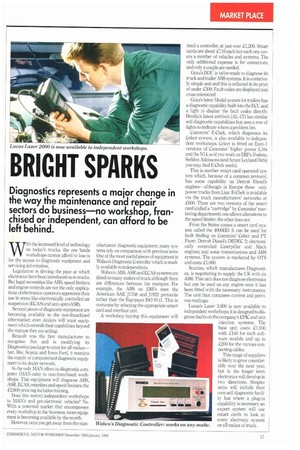BRIGHT SPARKS
Page 121

If you've noticed an error in this article please click here to report it so we can fix it.
ith the increased level of technology on today's trucks, the one battle workshops cannot afford to lose is for the access to diagnostic equipment and servicing information.
Legislation is driving the pace at which electronics have been introduced Onto trucks. But legal necessities like ABS, speed limiters and engine controls are not the only applications of electronics: operators appreciate their use in areas like electronically controlled air suspension (ECAS) and anti-spin (ASR).
Several pieces of diagnostic equipment are becoming available to the non-franchised aftermarkeh even dealers will want equipment which extends their capabilities beyond the marque they are selling.
Renault was the first manufacturer to recognise this and is modifying its Diagnostica package to cater for all makes— but, like. Scania and Iveco Ford, it restricts the supply of computerised diagnostic equipment to its dealer network.
So far only MAN offers its diagnostic computer (MAN-cats) to non-franchised work shops. This equipment will diagnose ABS, ASR ECAS, retarders and speed limiters; the £2,800 price tag includes training.
Does this restrict independent workshops to MAN'S and pre-electronic vehicles? No. With a potential market that encompasses every workshop in the business, more equipment is becoming available by the month.
However, once you get away from the man
ufacturers' diagnostic equipment, many systems rely on comparison with previous tests. One of the most useful pieces of equipment is Wabco's Diagnostic Controller which is readily available to independents.
Wabco's ABS, ASR and ECAS systems are fitted on many makes of truck although there are differences between the marques. For example, the ABS on ERFs uses the American SAE J1708 and J1922 protocols rather than the European ISO 9141. This is overcome by selecting the appropriate smart card and interface unit.
A workshop buying this equipment will
need a controller, at just over £1,200. Smart cards are about £110 each but each one covers a number of vehicles and systems. The only additional expense is for connectors, and only a couple are needed.
Grau's DDU is tailor-made to diagnose its truck and trailer ABS systems. It is a relatively simple unit and this is reflected in its price of under £300. Fault codes are displayed and cross referenced.
Grau's latest Modal system for trailers has a diagnostic capability built into the ECU and a light to display the fault codes directly. Bendix's latest antilock (AL-4T) has similar self-diagnostic capabilities but uses a row of lights to indicate where a problem lies.
Cummins' E-Chek, which diagnoses its Celect system, is also available to independent workshops. Celect is fitted on Euro-1 versions of Cummins' higher power LlOs and the N14, so if you work on ERFs, k'oclens, Seddon Atkinsons (and future Leyland Dafs) you may find E-Chek useful.
This is another smart card operated system which, because of a common protocol, has some capability on Detroit Diesel's engines—although in Europe these only power trucks from Liaz. E-Chek is available via the truck manufacturers' networks at £600. There are two versions of the smart card (called a "cartridge" by Cummins' marketing department): one allows alterations to the speed limiter, the other does not.
From the States comes a smart card system called the 40001ID. It can be used for fault finding on Cummins' Celect and PT Pacer; Detroit Diesel's DEDEC 2; electronically controlled Caterpillar and Mack engines; and some transmissions and ABS systems. The system is marketed by 0Th and costs £1,000.
Souriau, which manufactures Diagnostica, is negotiating to supply the UK with its 4080. This unit does not diagnose electronics but can be used on any engine once it has been fitted with the necessary instruments. The unit then compares current and previous readings.
Lucas's Lazer 2,000 is now available to independent workshops; it is designed to disgnose faults on the company's EPIC and unit injection systems. The base unit costs £1,100 with £140 for each software module and up to £200 for the various connecting cables.
This range of suppliers is likely to grow considerably over the next year, but in the longer term electronics will develop in two directions. Simpler units will include their own self diagnostic facility but where a plug-in capability is necessary an expert system will use smart cards to look at every electronic system on all makes of truck.
































































































































